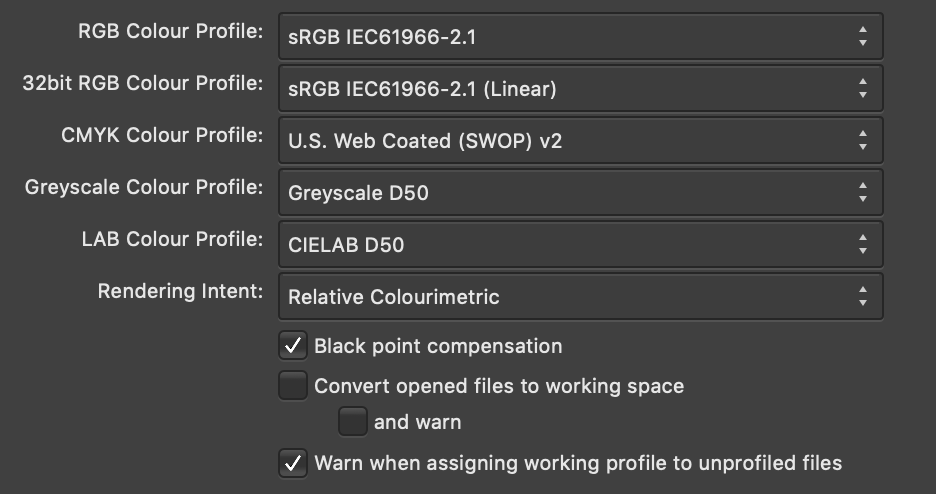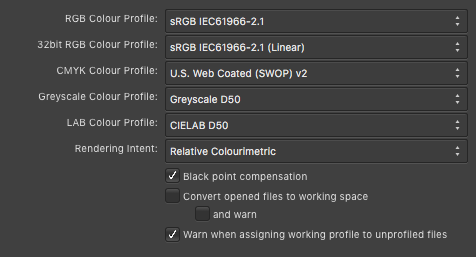
benwiggy
-
Posts
155 -
Joined
-
Last visited
Posts posted by benwiggy
-
-
I'm seeing a few errors when opening PDFs into Publisher (and Designer) with some text objects being positioned incorrectly. Also ligature glyphs are replaced by a ?.
Occasionally, some other glyph substitutions. I've no reason to suspect the PDFs themselves, as they behave in all other apps.
-
On 3/7/2019 at 6:40 PM, Jeremy Bohn said:
I haven't been able to test, but this might work. Right-click on your PDF file and choose Open With > ColorSync Utility. Once it's opened, at the bottom of the window there is a Filter popup menu. Pick "Create Generic PDFX-3 Document", then click apply. This is based on El Capitan, but hopefully it hasn't changed in Mojave.
This supposedly will make it a CMYK PDF.
Affinity Publisher can of course export PDFs as /X-3 standard.
Apple's own ColorSync Filter for "Generic PDF/X-3" is quite poor. It sets transparency resolution to 72dpi, for starters. Quartz Filters haven't changed since OS X 10.0.0.
-
Is it possible for the File Export options to be saved with the document? Currently, whenever I save a PDF, I have to change the default of "All Spreads" to "All Pages", every time. (Unless I'm missing something?)
That option doesn't seem to be part of the Presets.
-
I'm trying to resize an image in Affinity Photo. All the web pages, videos etc, talk about using the Document menu; but I don't have a Document menu.
Has something changed?
-
Apologies if this has been asked and answered already, but has Serif given any indication of the approximate, likely release date (even if it's just "Autumn 2026"
 )? Or, like my dinner, will it be released "When it's ready and not before."...?
)? Or, like my dinner, will it be released "When it's ready and not before."...?
It would be helpful for planning my own forthcoming projects. Thanks. -
The Print dialog now correctly shows a preview of the page, instead of a blank, without having to adjust the print presets.
Actual printing is also behaving.
-
Publisher works well with FontExplorerX, which will automatically enable required fonts in opened documents.
-
3 hours ago, Pauls said:
sometimes swapping the scaling option corrects it but we've not actually been able to recreate it on site which is frustrating
Yes, changing the scaling option fixes it: even changing it to 99% and then back to 100% fixes it. Changing to "Fit to Printable" also fixes it (even if the % stays at 100.)
Switching print queues 'restores' the blank page, even if all the settings are retained. So it's nothing about the settings themselves.
It's blank on my HP Laserjet 5200, but works correctly on my HP Color Laserjet 200 M251.Most interesting, I also have two of my own CUPS backends (simple Unix scripts) as print queues: one shows blank, the other works. The only difference between them is the PPD. It's possible that tiny differences in the paper sizes might be a factor?
-
Yes, I know how to fix it, but I'm wondering why Affinity 'claims' those types in the LaunchServicesDB in the first place. I don't think simply being the last app installed that uses those filetypes gives it priority, but I could be wrong. I think it depends on the contents of the BNDL data in the app's Info.plist.
-
Two of my four print queues show nothing at all in the print dialog preview; nor do they actually print anything. Nor Save as PDF.
It's possible that it relates to mono/colour, with the mono queues not working. Changing colour spaces does nothing.
-
Affinity Publisher is now the default app to open svg and ai files. Surely these files are less likely to be double-clicked into Publisher, but rather imported within an existing document? I would expect Affintiy Design to take the default for these file types.
-
There are several posts on the Designer and Photo forums requesting some sort of Automation, so I thought I'd echo the sentiment here.
It would be great to see the Affinity Suite using AppleScript, or JavaScript or Lua. Or python! (Assuming I'm not missing something!)
There are many people who are dependent on Adobe because of the scripting capabilities.
-
I also get blank output when printing or saving to PDF on 3 of my print queues. Everything works fine on 1 other queue (my HP color laser).
-
They've created a booklet interface control in the Print menu, so I'd say it's likely to be included at some stage, even if it doesn't work now.
If you already use a third-party PDF booklet maker from ID, (which has had built-in booklets since CS3), then surely you wouldn't be wasting your time doing the same from AP (assuming there are other benefits over ID)?
-
-
-
-
Is there any movement on Publisher? It was originally due at the end of 2016....

For the time being, I'm using VivaDesigner, which has a free entry-level app, and imports .idml files from InDesign. But I'd move over to something from Affinity in a heartbeat.
-
There was talk a while ago about an Affinity DTP app. I couldn't find anything on a forum search.
Don't suppose there's any news?
-
The OpenType versions of the Garamond fonts (with *.otf extension ) are available as a free download from a number of sites. If Adobe is selling a Garamond font package for $169.00 USD, how do others get away with giving them away from free? Are those files compromised in some way? Would they work with AD? Are they simply undercutting Adobe?
Without knowing more about which sites are giving them away, I would suspect that they are illegal downloads. While fonts are not executable files, I would still be wary of what the "payload" of such downloads contained.
-
There was talk of a DTP app by the end of the year? Is that on the cards yet? (Very excited -- that would pretty much move me away from Adobe entirely.)
Also there's lots of Aperture users looking for a replacement....
-
Something here doesn't add up. Fonts marked OsF (Old Style Figures) and SC (Small Caps) are Type 1 PostScript fonts, which needed another set for these features to get around the limitation of glyph numbers in T1 fonts (256).
Adobe's OpenType Garamond fonts have OsF and SC built into to them. There is no Adobe OpenType font file just for Small Caps. Also, both the OTF and T1 PostScript versions of Adobe Garamond are not free downloads -- you pay for them, (or some come bundled with Adobe's software).
So either the client wants you to use the old Type 1 Adobe fonts, or they want you to use some dodgy free download, or .. something else!
And generally, you don't import fonts into a program, just into the OS, where they are available for all.
-
Ah. Yes, I've also posted about this. Good that it's a popular thing.
-
Apple's website says that in El Capitan, Photos.app will support app extensions. Could I ask that you look into this? It's unclear whether this will include the ability to Edit in External, as in iPhoto/Aperture, but any enhancement of Photos with features from AP would be a real killer feature.
Thanks





Ligatures not recognised in pdf
in [ARCHIVE] Publisher beta on macOS threads
Posted
I've noticed problems with ligatures in imported PDFs, too, as well as other misalignment of text. I've continued to see problems after rinsing the PDF through PostScript and re-distilling with Acrobat; also re-saving from Preview, so blaming the PDF is not viable. The PDFs display fine in Illustrator and other graphics programs.
The only solution is to use Acrobat or GhostScript to outline the fonts in the PDF, and then Designer (or Publisher) will display the PDF correctly.